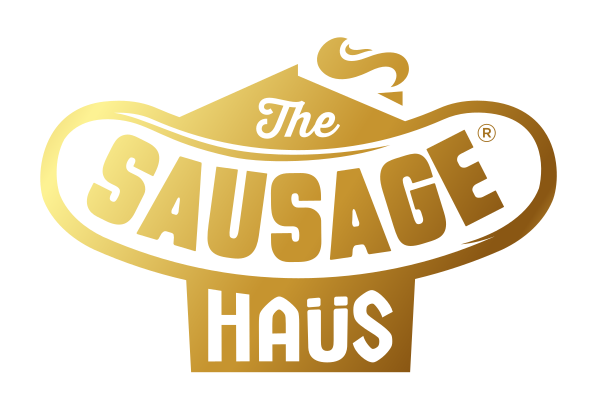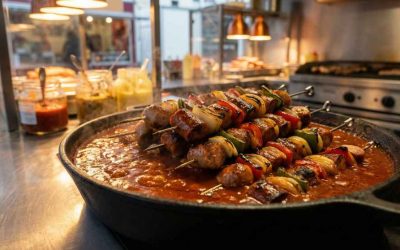Erfurt challenges Regensburg with a claim to Germany’s very first bratwurst stand
For centuries, Germany’s bratwurst has been more than just a sausage. It’s a symbol of tradition, regional pride, and culinary craftsmanship. Festivals, funfairs, and markets across the country – and increasingly across the UK – would be unthinkable without the smoky aroma of bratwurst sizzling on the grill.
But where, exactly, did the story of the bratwurst begin? Until now, Regensburg has proudly carried the title of “Home of the World’s Oldest Bratwurst Kitchen” with its famous Wurstkuchl on the Danube, which traces its origins back to 1378. Yet a new discovery in Erfurt could push that date back more than 100 years – and stir up one of Germany’s longest-running sausage rivalries.
A Surprising Find in Erfurt
Historians in Erfurt, the capital of Thuringia, have stumbled upon a remarkable document from the year 1269. While researching the history of the city’s iconic Krämerbrücke – a medieval bridge lined with merchants’ houses – scholars uncovered a reference to a small hut and a “bräter” (roaster or griller).
The description, they argue, may point to the existence of a bratwurst stand, predating Regensburg’s claim by over a century. Martin Sladeczek, project leader for Erfurt’s UNESCO World Heritage efforts, and historian Karl Heinemeyer suggest that this may be the earliest sign of bratwurst being sold at a permanent location.
Of course, the word “bratwurst” itself isn’t mentioned in the 1269 text. Still, as Sladeczek puts it: “We know what people ate in the Middle Ages: sausages and roasted meat.”
The Bratwurst Debate: Regensburg, Erfurt, or Somewhere Else?
This isn’t the first time sausage history has sparked debate. About 25 years ago, Regensburg fought off a challenge from Nuremberg, another proud bratwurst stronghold. Nuremberg has written records from 1313 mentioning minced pork for sausages – but critics point out that this doesn’t necessarily mean bratwurst.
Meanwhile, the oldest direct mention of the word bratwurst comes from Arnstadt in 1404, where a receipt records money spent on “bratwurst casings”. According to Thomas Mäuer from the German Bratwurst Museum in Mühlhausen, that makes Arnstadt the rightful birthplace of bratwurst in writing.
So who is right? Regensburg with its historic kitchen, Erfurt with its 1269 grilling stand, or Arnstadt with its first written “bratwurst” reference?
Like many culinary traditions, the truth is probably more complex. Bratwurst, in some form, was likely eaten long before anyone bothered to write it down. And as every region in Germany proudly reminds you – their bratwurst is the original.
More Than a Title – A Cultural Icon
What makes this debate more than just a bit of sausage rivalry is the symbolic value of the bratwurst. In Thuringia, the bratwurst is officially recognised as part of cultural heritage. In Bavaria, it’s inseparable from beer gardens and festivals. In Franconia, tiny “Nürnberger Bratwürste” are protected by EU law.
For locals, the title of “first bratwurst” isn’t just historical trivia – it’s a matter of identity. But as Alexandra Meier, the current host of Regensburg’s Wurstkuchl, says: “People come for the quality, not the title.”
And perhaps that’s the real story: whether grilled under the arches of Erfurt’s Krämerbrücke, beside the Danube in Regensburg, or at your own back garden BBQ, bratwurst endures because of its timeless taste and the care that goes into making it.
What This Means for the UK
For UK customers – whether retailers, caterers, or foodservice providers – the story of bratwurst’s origins only adds to its appeal. Behind every sausage is not just meat and spice, but centuries of history, debate, and pride. When you serve authentic German bratwurst, you’re offering your customers more than food – you’re sharing a slice of cultural heritage.
At The Sausage Haus, we’re proud to carry on this tradition. Our bratwursts are made to authentic German recipes, combining high-quality pork with the classic seasonings that have made these sausages beloved for generations. They’re perfect for:
- Christmas markets – where customers expect that familiar taste of Germany.
- Funfairs and festivals – quick, filling, and delicious street food.
- Pubs and restaurants – as part of hearty winter menus or summer BBQ specials.
Whether Erfurt, Regensburg, or Arnstadt can claim to be the very first, one thing is certain: bratwurst belongs to everyone who enjoys it today.
Bringing the Bratwurst Legacy to Your Customers
As we look ahead to winter markets, spring festivals, and summer BBQs, one fact remains clear – bratwurst sells. Its rich flavour, versatility, and cultural recognition make it a powerful addition to any menu or retail range.
So, while historians may continue debating over parchments and place names, we in the sausage business can celebrate a more practical truth: wherever it first sizzled on a grill, bratwurst has stood the test of time. And with our range of authentic German sausages, you can bring that history directly to your customers.
In Conclusion
Does the bratwurst story need to be rewritten? Perhaps. But whether it started in Erfurt in 1269, Regensburg in 1378, or Arnstadt in 1404, what matters most is that the bratwurst tradition is alive and thriving today – and that your customers can enjoy it as authentically in the UK as in Germany.
At The Sausage Haus, we’re honoured to continue this legacy – one delicious sausage at a time.
This information was found in the German magazine Der Spiegel.



